
Norman Graham Hill was a British racing driver, rower and motorsport executive, who competed in Formula One from 1958 to 1975. Nicknamed "Mr. Monaco", Hill won two Formula One World Drivers' Championship titles and—at the time of his retirement—held the record for most podium finishes (36); he won 14 Grands Prix across 18 seasons. In American open-wheel racing, Hill won the Indianapolis 500 in 1966 with Mecom. Upon winning the 24 Hours of Le Mans in 1972 with Matra, Hill became the first—and to this date, only—driver to complete the Triple Crown of Motorsport.
The Surtees Racing Organisation was a race team that spent nine seasons as a constructor in Formula One, Formula 2, and Formula 5000.
Lola Cars Limited is a British automobile manufacturer founded in 1958 by Eric Broadley in Bromley, England. The company is now owned by Till Bechtolsheimer, which he purchased in 2022. Lola Cars endured for more than fifty years to become one of the oldest and largest manufacturers of racing cars in the world. Lola started by building small front-engine sports cars, and branched out into Formula Junior cars before diversifying into a wider range of sporting vehicles. In 2012, Lola Cars stopped operations. Lola is set to make a return to motorsport in 2024 by joining the Formula E World Championship as a powertrain supplier in a technical partnership with Yamaha with Abt as their customer.

Thomas Maldwyn Pryce was a British racing driver from Wales known for winning the Brands Hatch Race of Champions, a non-championship Formula One race, in 1975 and for the circumstances surrounding his death. Pryce is the only Welsh driver to have won a Formula One race and is also the only Welshman to lead a Formula One World Championship Grand Prix: two laps of the 1975 British Grand Prix.

The 1975 Spanish Grand Prix was a Formula One motor race held at Montjuïc circuit on 27 April 1975. It was race 4 of 14 in both the 1975 World Championship of Drivers and the 1975 International Cup for Formula One Manufacturers. It is a landmark, controversial, and tragic race weekend. Lella Lombardi became the first and, as of 2024, only woman to score points in the World Championship. Lombardi scored 0.5 points as this was the first time a race was stopped before 60% completion leading to the awarding of half the points that would be awarded for a completed race. During the race four spectators were hit by the Hill GH1 of Rolf Stommelen, after he crashed and landed in a spectator area, causing their deaths. The race was also future world champion Alan Jones' first Grand Prix start.

The 1975 Italian Grand Prix was a Formula One motor race held at Monza on 7 September 1975. It was race 13 of 14 in both the 1975 World Championship of Drivers and the 1975 International Cup for Formula One Manufacturers. It was the 45th Italian Grand Prix and the 41st to be held at Monza. The race held over 52 laps of the five kilometre circuit for a race distance of 300 kilometres.
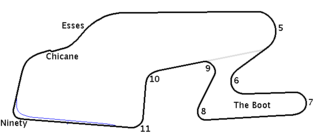
The 1975 United States Grand Prix was a Formula One motor race held on October 5, 1975, at the Watkins Glen Grand Prix Race Course in Watkins Glen, New York. It was race 14 of 14 in both the 1975 World Championship of Drivers and the 1975 International Cup for Formula One Manufacturers. It was the 25th United States Grand Prix since the first American Grand Prize was held in 1908 and the 18th since the first United States Grand Prix at Riverside in 1958.
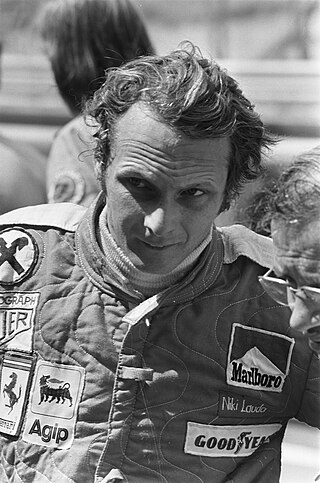
The 1975 Formula One season was the 29th season of FIA Formula One motor racing. It featured the 1975 World Championship of F1 Drivers and the 1975 International Cup for F1 Manufacturers which were contested concurrently from 12 January to 5 October over fourteen races. The season also included three non-championship Formula One races and a nine race South African Formula One Championship.

The 1962 Formula One season was the 16th season of FIA Formula One motor racing. It featured the 13th World Championship of Drivers, the 5th International Cup for F1 Manufacturers, and numerous non-championship Formula One races. The World Championship was contested over nine races between 20 May and 29 December 1962.

Rolf Johann Stommelen was a racing driver from Siegen, Germany. He participated in 63 Formula One World Championship Grands Prix, achieving one podium, and scored a total of 14 championship points. He also participated in several non-Championship Formula One races.
Anthony William Brise was an English racing driver, who took part in ten Formula One Grand Prix events in 1975, before dying in a plane crash with Graham Hill.
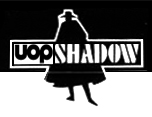
Shadow Racing Cars was a Formula One and sports car racing team.
Eric Harrison Broadley MBE was a British entrepreneur, engineer, and founder and chief designer of Lola Cars, the motor racing manufacturer and engineering company. He was arguably one of the most influential automobile designers of the post-war period, and over the years Lola was involved with many high-profile projects in Formula One, Indy car, and sports car racing. Broadley sold Lola to Martin Birrane in 1997.
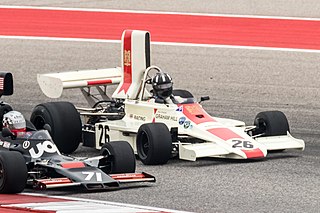
The Hill GH1 was a Formula One car used by Embassy Hill during the 1975 Formula One season. It was designed by Andy Smallman. The car was initially designated as the Lola T371, but when Smallman left Lola to work full-time for Embassy Hill it was renamed as the Hill GH1. GH1 cars participated in 12 World Championship Grands Prix in 1975, with 21 entries in total using six different drivers. Two points finishes yielded 11th place in the World Constructors' Championship, with three points.
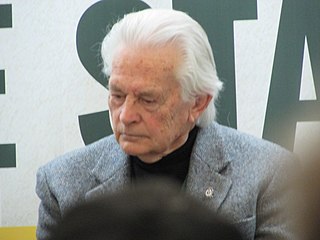
Tony Southgate is an English engineer and former racing car designer. He designed many successful cars, including Jaguar's Le Mans-winning XJR-9, and cars for almost every type of circuit racing. He was responsible for the chassis design of Ford's RS200 Group B rally car. Southgate was employed as chief designer or technical director for many Formula One teams for over twenty years. These teams included BRM, Shadow and Arrows. Southgate retired after producing the Audi R8C, which was a major influence in the Bentley Speed 8, which won Le Mans in 2003. He continues to be a regular visitor to current and historic race meetings.

The Shadow DN1 was a Formula One car used by the Shadow team during the 1973 Formula One season and the early stages of the following season. The car was the first Formula One car for Shadow, which had previously participated in the CanAm Sportscar Series. It was designed by former BRM engineer Tony Southgate. The DN1 was also driven by Graham Hill for his privateer team, Embassy Hill.

The Lola T370 was a Formula One car designed by Andy Smallman and used by Embassy Hill in the 1974 season and the early part of the 1975 season. After an unsuccessful 1973 with a customer Shadow DN1, the Embassy Hill team commissioned its own cars from Lola. The T370 was largely based on Formula 5000 designs, and looked similar to Lola's F5000 cars, although it sported an extremely large airbox. Embassy Hill had two cars for Graham Hill and Guy Edwards. The car was tested well before the end of 1973 in readiness for the January start to the 1974 season.

The Williams FW was a Formula One car used by Frank Williams Racing Cars during the 1973, 1974 and 1975 seasons. It was designed by John Clarke.

The Williams FW04 was a Formula One car used by Frank Williams Racing Cars during the 1975 season and Wolf–Williams Racing during the 1976 season. The car was a development of the Williams FW and two were built. Although not a particularly successful car, an FW04 finished second at the 1975 German Grand Prix.

On 29 November 1975, former Formula One champion and Embassy Hill team owner Graham Hill died when the Piper Aztec light aircraft he was piloting crashed near Arkley in Hertfordshire, United Kingdom, while on approach to Elstree Airfield. The other five passengers on board, forming the core of his Formula One team, were also killed.



















